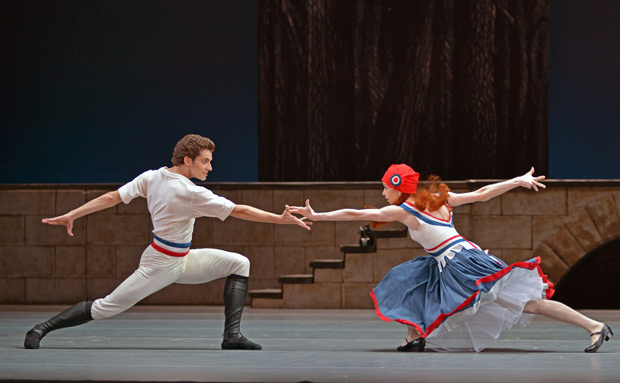
© Dave Morgan. (Click image for larger version)
Bolshoi Ballet
The Flames of Paris
★★★★✰
London, Royal Opera House
5 August 2016
Gallery of pictures by Dave Morgan
www.bolshoi.ru
www.roh.org.uk
The great pleasure of Alexei Ratmansky’s version of Vasily Vainonen’s 1932 ballet is the cornucopia of steps to which both choreographers had access: danse d’école, folk and character dances, as well as expressive acting. Vainonen and his librettists may have had to please Stalin with the plot of The Flames of Paris, but he gave dancers plenty of chances to display their talent and training, first in Leningrad, and then in Moscow. Ratmansky has kept Vainonen’s choreography where he can, contributing his own variations in the same vein and a different political awareness.
He has simplified the story of heroic French revolutionaries, reducing the ballet from four acts to two. The first act takes place somewhere near Marseilles in 1789, as disaffected rebels are making their way to overturn the monarchy in Paris. Vainonen’s ballet was first given on the 15th anniversary of the 1916 October Revolution, a forerunner of the big-scale Russian Revolution in 1917: armed uprisings and regime change were still fresh in Soviet audiences’ minds.
Revolutionary fervour excites local folk-dancing peasants, including a brother and sister, Jerome and Jeanne, as a Marseillais battalion passes through their area. Ratmansky skilfully distinguishes the siblings’ relationship in a boisterous pas de deux, in which Jerome (eager Denis Savin) yanks Ekaterina Krysanova’s tomboyish Jeanne around, eventually brandishing her like a banner between him and the battalion leader, Vitaly Biktimirov.
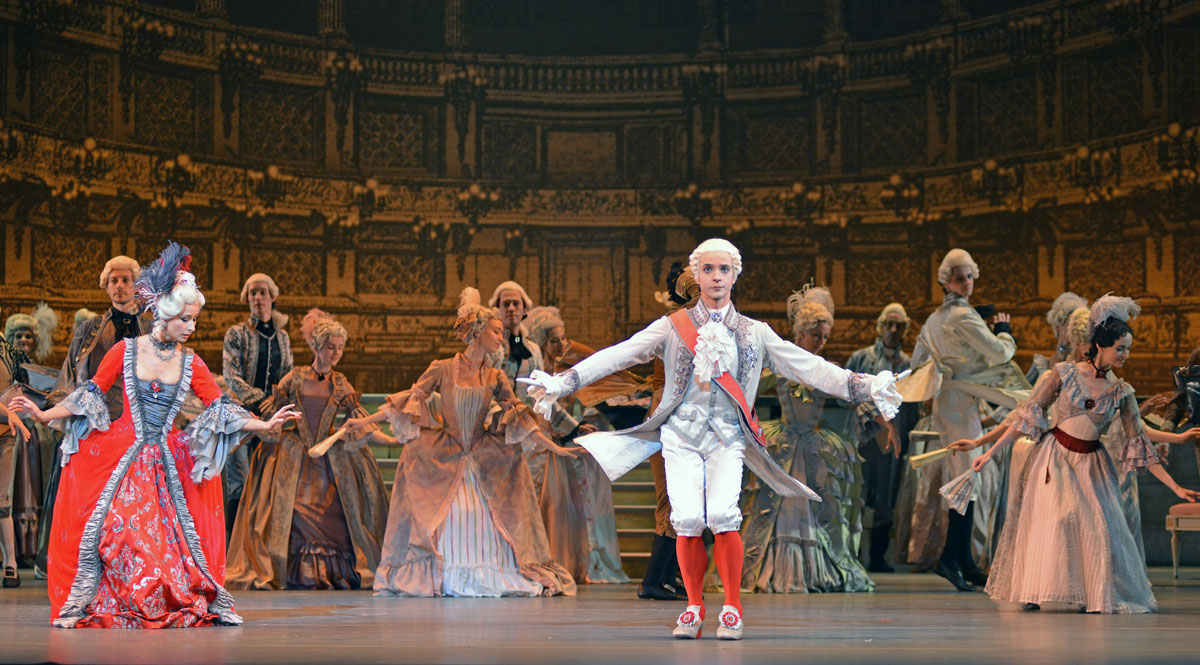
© Dave Morgan. (Click image for larger version)
The arrival of an aristocratic hunting party provides a pretext for a virile quartet of huntsmen and a paternal duet for the Marquis (Semyon Chudin) and his lovely daughter (Nina Kaptsova). When the Marquis starts assuming his droit de seigneur over Jeanne, Jerome rushes to her aid. He is arrested and thrown into jail (thanks to a swift change of set). Adeline frees him, sparking a potential love affair as doomed as that between Romeo and Juliet.
The other love story involves Jeanne and Philippe (Igor Tsvirko), a handsome rebel. Infatuated by his kiss, and outraged by the Marquis’s behaviour, Jeanne joins the Marseillais fighters, as does Jerome. In a brief, touching scene, they bid farewell to their distraught parents. Ratmansky emphasises the human cost of revolutionary fervour, setting individuals’ stories against historical events.
Boris Asafiev’s score is closely based on French music popular at the time of the Revolution – including, of course, La Marseillaise. For the next scene in King Louis XIV’s palace, Asafiev also provided an 18th century minuet and masses of music for a ballet de cour divertissement. The tale of Rinaldo and Armida occupies the place of a typical vision scene, in which a slender tale is told through elaborate classical dancing: bliss for those who love the intricacies of academic ballet technique, tedious for those longing for the interval.
Ratmansky enjoys, as do the performers, the range of steps, styles and tempi he can employ: speedy and cute for Amour (Daria Khokhlova, Cupid in Don Q’s vision scene), feminine elegance for Armida’s attendant nymphs, Soviet melodrama for the Furies, fiendish Vainonen and Petipa variations for Rinaldo and Armida (Artem Ovcharenko and Anna Tikhomirova). The preposterous going-ons are sent up discreetly by the leading couple, challenged to accomplish technical feats with insouciance in daft period costumes. Tikhomirova and Ovcharenko delighted us and themselves, acknowledging our applause as though we were members of the court.

© Dave Morgan. (Click image for larger version)
King Louis XVI and Queen Marie Antoinette arrive after the performance is over – advisedly, since he is no dancer, unlike Louis XIV. A ridiculous pair of rulers, they and their court of acolytes are clearly doomed, as the strains of the Marseillaise are heard outside the palace. (There are many similarities with Act II of Kenneth MacMillan’s Anastasia, in which the Tsar’s court, diverted by a classical pas de deux, is invaded by Russian revolutionaries.)
In The Flames of Paris second half, the revolutionaries are preparing to take over the Tuileries palace. By now, they are mixed lot of peasants, sans-culottes, urban bourgeois and soldiers, mostly more interested in regaling themselves with drink and dancing than with risking their lives. After each exuberant dance from the Auvergne, Marseille and Basque regions, the performers acknowledge our applause: we have become revolutionaries too. The crowd are still communities of individuals, further animated by feisty little Marseillaise Evgenia Savarskaya, Biktimirov’s bluff captain, and militant Jeanne, who leads the wild carmagnole dance.
Her brother Jerome, initially a fervent believer in the revolutionary cause, is distracted by the presence of Adeline, who has joined the rebels. They declare their love in a sincere pas de deux of yielding backbends and a lift in which, like Juliet, her heart is held up to the heavens. The duet, in Ratmansky’s lyrical choreography, is unlike anything in the ballet in its poignancy.
Meanwhile, the ancien régime has been overthrown and a makeshift republican government installed. The ceremony requires another balletic charade, performed by the same troupe who danced for the deposed King’s court. The virtuoso pas de deux, however, goes to Jeanne and Philippe, who are to be newly-weds under the new regime. Philippe has so far been a minor character in the drama, a rather unsatisfactory match for passionate Jeanne, who is fast becoming a fanatic. Tsvirko finally made his mark in Vainonen’s choreography for the engagement pas de deux, which is often given as a gala number.

© Dave Morgan. (Click image for larger version)
When Ivan Vasiliev danced the role, he was far more conspicuous, hurtling through the pas de deux as a showcase for his remarkable elevation. His Philippe took over as the charismatic leading character in the ballet, whereas Jerome is the real hero. Tsvirko was intense, putting all his effort into nailing the twisting leaps and committing himself as a partner for Krysanova. (Unreliable Philippe is supposed to be drunk before he is called upon to dance.) Krysanova sailed through the challenging choreography, having swiftly exchanged her heeled character shoes for pointe shoes. She is a truly versatile dance-actress – and, as Jeanne, a headstrong partisan of the revolution.
Jeanne has no pity for the condemned Marquis who demeaned her. The unruly crowd demand his execution, and that of Adeline, who pleads for her father’s life. Violent uprisings breed terror, and Adeline’s brutal beheading is all too familiar. The stage turns red as the crowd celebrates to Ça ira, the battle song of the triumphant sans-cullottes. They surge forward towards the audience, as inconsolable Jerome cradles Adeline’s guillotined head. Apparently Stalin loved Vainonen’s use of the militant crowd when its march was placed earlier, en route to the Tuilerie palace. Ratmansky puts mob rule at the end, to chill our blood.












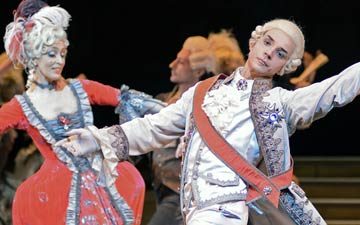

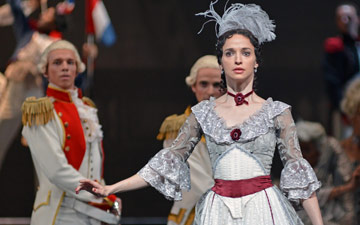
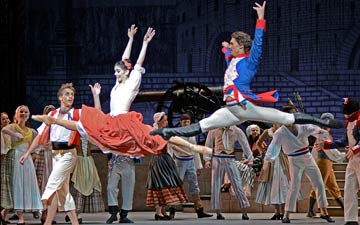
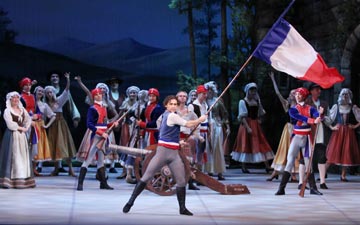
The review, like the ballet sounds, is a wow! I wonder if the Bolshoi will ever show it in the U.S., given some of our recent single and violent incidents.
Forgot to mention that the male solo, so now used in competition s and galas, was performed at the Jackson Competition by Joseph Phillips, who took the junior gold
that year. He then went on toe San Francisco Ballet and American Ballet Theatre before beocming a principal dancer in Vladivostok [hope the spelling is correct]. He remarked to me that once he danced it as a solo, then subsequent competitions saw it featured frequent by young competitors.